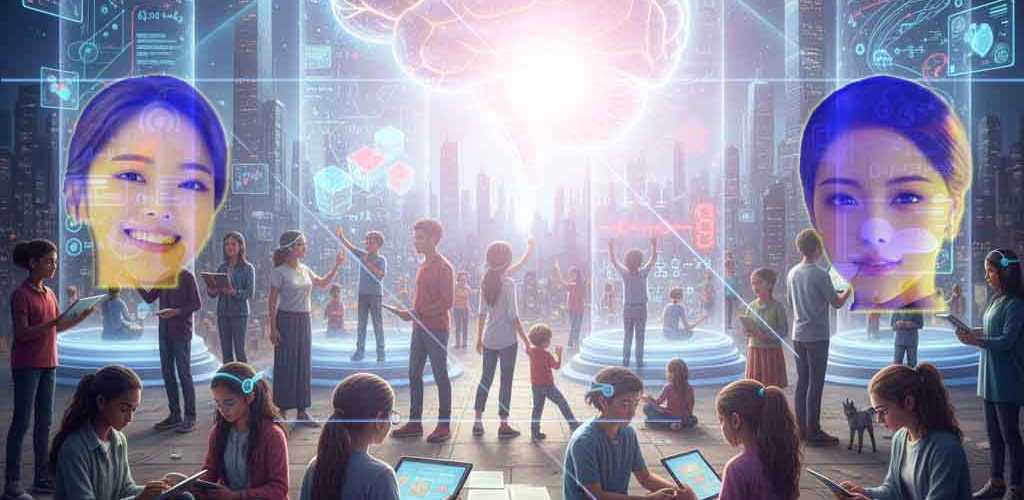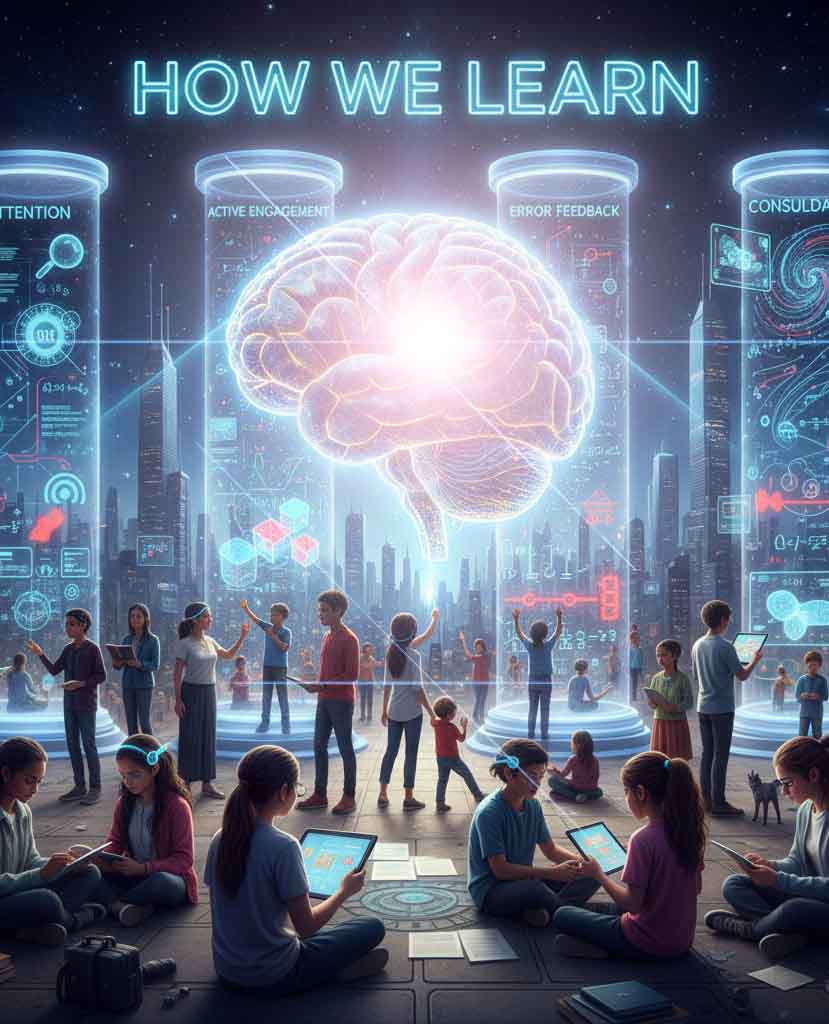우리의 뇌는 어떻게 배우는가(학습 대화)
10월 17, 2025

저자(Author) : 스타니슬라스 드앤 Stanislas Dehaene

▩ 한국어 버전 <<< [우리의 뇌는 어떻게 배우는가(학습 대화)]
![]() Amy
Amy
안녕하세요!
최근에 ‘스타니슬라스 드앤‘의 『우리의 뇌는 어떻게 배우는가(How We Learn)』라는 책을 읽었는데,
학습에 대한 제 생각이 완전히 바뀌었어요.
이 책의 핵심 내용에 대해 대화 형식으로 이야기해 볼까요?
![]() Barbara
Barbara
네, 정말 흥미로운 책이죠!
‘드앤’ 교수는 우리 뇌가 단순한 ‘정보 흡수 장치’가 아니라 아주 특별한 학습 시스템을 갖추고 있다고 설명하는데,
그게 가장 인상적이었어요.
이 책의 가장 근본적인 주장은 무엇이었나요?
![]() Amy
Amy
가장 중요한 건, 배움에 대한 기존의 이해를 뒤집는다는 점이에요.
흔히 인간이 태어날 때 ‘빈 서판(Tabula Rasa)’이라고 생각했지만, 뇌 과학 연구는 그게 틀렸다고 말합니다.
‘드앤’은 뇌가 이미 수학, 확률, 공간 지각 같은 선천적 지식을 가지고 태어난다고 설명하죠.
![]() Barbara
Barbara
맞아요.
아기가 이미 태어날 때부터 학습을 위한 ‘부트스트랩(자가 발전)’ 시스템을 갖추고 있다는 거군요.
그렇다면 이 책에서 정의하는 ‘배움’이란 정확히 무엇인가요?
![]() Amy
Amy
배움은 단순한 정보 암기가 아니에요.
외부 세계에 대한 정확한 내부 모델(가설)을 뇌 속에 구축하는 과정이에요.
그리고,
새로운 경험을 할 때마다 그 모델이 맞는지 끊임없이 시험하고 조정하는,
마치 작은 과학자처럼 활동하는 거라고 합니다.
![]() Barbara
Barbara
정말 멋진 비유네요.
그 ‘과학자 뇌’를 더 효율적으로 작동하게 만드는,
즉 학습을 획기적으로 향상시키는 ‘네 가지 기둥’에 대한 내용이 가장 실용적이었죠?
그 네 가지가 뭐였는지 정리해 주시겠어요?
![]() Amy
Amy
물론이죠.
모든 학습에 적용되는 뇌의 핵심 알고리즘 4가지입니다.
첫 번째, 주의 (Attention)입니다.
배움은 선택적 집중에서 시작됩니다.
뇌는 중요한 정보에만 주의를 기울여 정보를 증폭시키고 나머지는 무시합니다.
효과적인 학습의 첫걸음은 의도적인 집중입니다.
두 번째, 적극적 참여 (Active Engagement) 입니다.
수동적인 듣기보다 능동적으로 가설을 세우고 탐구할 때 뇌가 가장 잘 배웁니다.
특히 궁금증(Curiosity)이 이 참여를 이끌어내는 핵심 동력이라고 했어요.
세 번째, 에러 피드백 (Error Feedback) 입니다.
실수는 배움의 필수 요소라는 점을 강조합니다.
예측과 실제 결과 사이의 불일치(에러 신호)가 발생할 때, 뇌는 기존 모델을 수정하고 새로운 학습을 만들어냅니다.
실수를 두려워하면 안 되는 이유죠.
네 번째는, 통합 (Consolidation) 입니다.
새로운 지식은 반복과 수면을 통해 무의식적이고 자동적인 단계로 전환되어야 합니다.
그래야 비로소 장기 기억으로 자리 잡고 효율적으로 활용될 수 있습니다.
![]() Barbara
Barbara
이 네 기둥은 정말 교육 현장에 바로 적용해야 할 원리 같아요.
마지막으로, ‘드앤’ 교수는 뇌의 어떤 능력 때문에 우리가 인공지능(AI)보다 우월하다고 보는 걸까요?
![]() Amy
Amy
바로 ‘가소성(Plasticity)’과 ‘효율성’ 때문입니다.
뇌는 나이에 상관없이 평생 변화하고 재구성될 수 있는 가소성을 가지고 있어요.
게다가 인간의 뇌는 AI가 막대한 데이터를 필요로 하는 것과 달리,
훨씬 적은 데이터로도 추상적인 개념을 배우고 다방면으로 활용할 수 있다는 점에서
훨씬 강력하고 효율적인 학습 기계라는 거죠.
![]() Barbara
Barbara
명확한 요약 감사합니다.
결국 이 책은 뇌 과학적 원리를 이해하고 네 가지 기둥을 활용하여,
우리 모두가 뇌를 더 잘 사용할 수 있는 통찰을 제공하는 셈이네요!
▩ English version <<< [How We Learn(Learning Conversation)]
![]() Amy
Amy
Hello!
I recently read a book called “How We Learn” by Stanislas Dehaene,
My thinking about learning has completely changed.
Let’s talk about the core content of this book in a conversational format?![]() Barbara
Barbara
Yes, it’s a really interesting book!
Professor Dehaene explains that our brains are not just ‘information absorption devices’ but have a very special learning system,
That was the most impressive.
What was the most fundamental argument of this book?![]() Amy
Amy
Most importantly, it reverses the existing understanding of learning.
It was often thought of as a “Tabula Rasa” when humans were born, but brain science research says it is wrong.
Dehaene explains that the brain is already born with innate knowledge such as mathematics, probability, spatial perception.![]() Barbara
Barbara
That’s right.
You mean the baby already has a ‘bootstrap’ system for learning from birth.
So what exactly is ‘learning’ as defined in this book?![]() Amy
Amy
Learning is not just about memorizing information.
It is the process of building an accurate internal model (hypothesis) of the outside world in the brain.
And,
Whenever I have a new experience, I constantly test and adjust to see if the model is right,
It’s said to act like a small scientist.![]() Barbara
Barbara
What a wonderful metaphor.
It makes that scientist brain work more efficiently,
In other words, the content of the “four pillars” that dramatically improve learning was the most practical, right?
Can you sort out what those four things were?![]() Amy
Amy
Sure.
These are the four key algorithms of the brain that apply to all learning.
First, attention.
Learning begins with selective concentration.
The brain only pays attention to important information, amplifying it and ignoring the rest.
The first step in effective learning is intentional concentration.
Second, active engagement.
The brain learns best when actively hypothesizing and exploring rather than passive listening.
Curiosity, in particular, is the key driving force behind this participation.
Third, error feedback.
Emphasize that mistakes are an essential part of learning.
When a discrepancy (error signal) occurs between predictions and real-world results, the brain modifies existing models and creates new learning.
That’s why you shouldn’t be afraid of mistakes.
Fourth, it’s consolidation.
New knowledge must be transformed into unconscious and automatic stages through repetition and sleep.
Only then can it be established as a long-term memory and used efficiently.![]() Barbara
Barbara
These four pillars really seem to be a principle that should be applied directly to the educational field.
Finally, what ability of the brain does Professor Dehaene see us as superior to artificial intelligence (AI)?![]() Amy
Amy
It’s because of ‘plasticity’ and ‘efficiency’.
The brain has plasticity that can change and be reconstructed throughout life, regardless of age.
In addition, the human brain needs huge amounts of data, unlike AI,
You can learn abstract concepts with much less data and use them in many ways
It’s a much more powerful and efficient learning machine.![]() Barbara
Barbara
Thank you for the clear summary.
Finally, this book understands the principles of brain science and uses four pillars,
That’s giving us all insight to use our brains better!


뇌를
더 잘 사용할 수
있는 통찰
<< 우리의 뇌는 어떻게 배우는가(학습 대화) >>
<< 같은 부류 Post(‘우리의 뇌는 어떻게 배우는가’) 바로가기 >>
베스트셀러 [‘우리의 뇌는 어떻게 배우는가‘] ✈ 책으로 읽기를 권장합니다.






